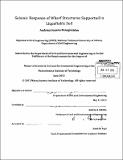| dc.contributor.advisor | Andrew J. Whittle. | en_US |
| dc.contributor.author | Panagiotidou, Andriani Ioanna | en_US |
| dc.contributor.other | Massachusetts Institute of Technology. Department of Civil and Environmental Engineering. | en_US |
| dc.date.accessioned | 2013-12-06T20:48:37Z | |
| dc.date.available | 2013-12-06T20:48:37Z | |
| dc.date.issued | 2013 | en_US |
| dc.identifier.uri | http://hdl.handle.net/1721.1/82845 | |
| dc.description | Thesis (S.M.)--Massachusetts Institute of Technology, Department of Civil and Environmental Engineering, 2013. | en_US |
| dc.description | Cataloged from PDF version of thesis. | en_US |
| dc.description | Includes bibliographical references (pages 108-110). | en_US |
| dc.description.abstract | This research analyzes the vulnerability of wharf structures supported on loose granular waterfront fills that are susceptible to liquefaction during seismic events and considers the effectiveness of pre-fabricated Vertical (PV) drain systems in mitigating potential damage. The analyses are based on non-linear finite element simulations using the OpenSees open-source software framework. The analyses make extensive use of an advance macroelement formulation by Varun (PhD, 2010), which captures efficiently the fundamental mechanisms of saturated granular soil behavior. The thesis explains in detail the mechanical components of the macroelement as well as the necessary calibration steps. Numerical simulations of a typical berth of port facilities on the US West coast have been carried out using as earthquake loading the time histories of free field displacements and of excess pore pressures predicted by Vytiniotis (PhD, 2011) at specific locations along the embedded length of piles (for a suite of 56 ground motions). The results show that the primary cause of the structural damage is indeed the lateral spreading of the soil and therefore retrofitting efforts should be targeted in limiting the development of pore pressures that cause the lateral spreading. This argument is then tested by comparing the performance in numerical simulations for the case where full-depth PV drains are installed at locations behind the crest of the slope (i.e. minimally-intrusive mitigation system) and for the case of a fully densified slope for the same suite of ground motions. These results indicate that soil improvement methods assist in reducing structural damage to pile-deck connection locations. The results also show that the densification of the slope is only marginally superior to the less intrusive improvement with PV-drains. | en_US |
| dc.description.statementofresponsibility | by Andriani Ioanna Panagiotidou. | en_US |
| dc.format.extent | 127 pages | en_US |
| dc.language.iso | eng | en_US |
| dc.publisher | Massachusetts Institute of Technology | en_US |
| dc.rights | M.I.T. theses are protected by
copyright. They may be viewed from this source for any purpose, but
reproduction or distribution in any format is prohibited without written
permission. See provided URL for inquiries about permission. | en_US |
| dc.rights.uri | http://dspace.mit.edu/handle/1721.1/7582 | en_US |
| dc.subject | Civil and Environmental Engineering. | en_US |
| dc.title | Seismic response of wharf structures supported in liquefiable soil | en_US |
| dc.type | Thesis | en_US |
| dc.description.degree | S.M. | en_US |
| dc.contributor.department | Massachusetts Institute of Technology. Department of Civil and Environmental Engineering | |
| dc.identifier.oclc | 863227993 | en_US |
